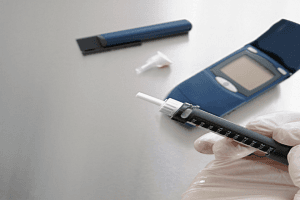Insulin resistance and diabetes

Swarna Anchal * and Chirag Sethi **
* Technical Writer, Classic Fitness Academy, New Delhi.
** Director, Classic Fitness Academy, New Delhi.
Digestive tract breaks down carbohydrates taken in meal and changes them into
glucose. Glucose is then absorbed into bloodstream. Once glucose is in your bloodstream,
insulin produced by pancreas causes cells throughout your body to absorb the sugar and
use it for energy. Insulin also helps balance your blood glucose levels. When there is too
much glucose in your bloodstream, insulin signals your body to store the excess in your
liver. The stored glucose will not be used until your blood glucose levels decrease.
 hInsulin resistance is the name given to when cells of the body don’t respond properly
hInsulin resistance is the name given to when cells of the body don’t respond properly
to the hormone insulin and sugar level in blood is elevated. When blood sugar levels exceed
a certain threshold, you may be diagnosed with type-2 diabetes. Insulin resistance is
associated with two very common conditions—metabolic syndrome and type-2 diabetes.
Diabetes occurs when blood sugar level exceeds normal level. Diabetes can be of two types:
type-1 and type-2 diabetes.
Type-1 diabetes is a type of autoimmune disease where body attacks its own pancreatic
cells and not able to produce insulin whereas Type-2 diabetes occurs when body has
stopped to response insulin produced by pancreas hence more insulin is needed to get the
same effects. Therefore, pancreas overproduces insulin to keep blood glucose levels normal
resulting in burning out of insulin-producing cells over a period of time. Other than these
two more forms of diabetes occurs however they are of temporary nature.
Prediabetes occurs when your fasting blood sugar is higher (>100 mg/dL) than normal but
not high enough (<126 mg/dL) for a diagnosis of type 2 diabetes. Gestational diabetes is
high blood sugar during pregnancy. Placenta produces Insulin-blocking hormones that cause
this type of diabetes.
Factors responsible for insulin resistance:
(1) Increased levels of fat in your blood due to overeating leads to weight gain and
obesity which strongly associated with insulin resistance (1). Belly fat, also known as
visceral or abdominal fat around your abdomen promotes inflammation and insulin
resistance, which drives hyperinsulinemia.
(2) High Fructose intake found in table sugar, honey and high-fructose corn syrup has
been linked to insulin resistance which ultimately drives insulin levels higher (2).
(3) Increased oxidative stress and inflammation in your body may lead to this condition
(3).
(4) Physical activity increases insulin sensitivity, while inactivity causes insulin resistance
(4).
3
(5) Disruption in the bacterial environment in your gut can cause inflammation that
exacerbates insulin resistance and other metabolic problems (5).
(6) Having low HDL (good) cholesterol levels and high blood triglycerides are two other
markers strongly associated with this condition (6).
(7) People with health conditions characterized by insulin resistance, such as metabolic
syndrome and polycystic ovary syndrome (PCOS) (7).
(8) Many researchers found that low amount of vitamin D is associated with insulin
resistance and β cells dysfunction (8).
Interestingly, you can often completely reverse this condition by changing your lifestyle in
the following ways:
(1) Exercise may be the single easiest way to improve insulin sensitivity. Combining
aerobic and resistance exercise seems to be the most effective for insulin sensitivity.
Other studies have shown that walking around, rather than sitting for prolonged
periods, can help in bringing down insulin levels from spiking after a meal (9).
(2) Tobacco smoking can cause insulin resistance, so quitting should help (10).
(3) Try to reduce your intake of added sugars, especially from sugar-sweetened
beverages (2).
(4) Eat a diet based mostly on whole, unprocessed foods and without refined carbs as
eating food with high-glycemic load raises your levels more than eating the same
portion of a low-glycemic load food.
(5) Omega-3 fatty acids may reduce insulin resistance, as well as lower blood
triglycerides. One study shows significant 8.4% decrease in insulin levels in a group
of women with PCOS who took fish oil (11).
(6) Supplements like Magnesium, may enhance insulin sensitivity and reduce blood
sugar (12).
(7) Some evidence suggests that poor sleep causes insulin resistance, so improving
sleep quality should help (13, 14).
(8) Try to manage your stress levels if you easily get overwhelmed. Meditation may be
particularly helpful.
(9) High levels of iron in your blood are linked to insulin resistance. For men and
postmenopausal women, donating blood may improve insulin sensitivity (15).
(10) Intermittent fasting, low-carb diets may fight insulin resistance and type-2 diabetes.
This type of fasting involves fasting or dramatically reducing calories one day and
eating normally the following day. Some studies have found it effectively lowers
insulin levels (16).
(11) By monitoring your portion size and consuming fewer calories has been shown to
increase insulin sensitivity and decrease insulin levels in obese individuals, regardless
of the type of diet they consume. Hence small meals taken 4-5 times a day are
recommended.
References:
(1) Isganaitis E, Lustig RH (2005). Fast food, central nervous system insulin resistance,
and obesity. Arteriosclerosis, Thrombosis, and Vascular Biology 25(12):2451–62.
(2) Macdonald IA (2016). A review of recent evidence relating to sugars, insulin
resistance and diabetes. European Journal of Nutrition 55(2):17–23.
(3) Peraldi P, Spiegelman B (1998). TNF-alpha and insulin resistance: summary and
future prospects. Molecular and Cellular Biochemistry 182(1–2):169–75.
(4) Kyu HH, Bachman VF, Alexander LT, Mumford JE, Afshin A, Estep K, Veerman JL,
Delwiche K, Iannarone ML, Moyer ML, Cercy K (2016). Physical activity and risk of
breast cancer, colon cancer, diabetes, ischemic heart disease, and ischemic stroke
events: systematic review and dose-response meta-analysis for the Global Burden of
Disease Study 2013. BMJ (Clinical Research) 354.
(5) Andrea MC and Mario JA Saad (2013). The Role of Gut Microbiota on Insulin
Resistance. Nutrients 5(3):829-851.
(6) Fossati P, Romon-Rousseaux M (1987). Insulin and HDL-cholesterol metabolism.
Diabetes Metabolism 13(3):390-4.
(7) Nafiye Y, Sevtap K, Muammer D, Emre O, Senol K, Leyla M (2010). The effect of
serum and intrafollicular insulin resistance parameters and homocysteine levels of
nonobese, nonhyperandrogenemic polycystic ovary syndrome patients on in vitro
fertilization outcome. Fertility and Sterility 93(6):1864–9.
(8) Chiu KC, Chu A, Go VL, Saad MF (2004). Hypovitaminosis D is associated with insulin
resistance and beta cell dysfunction . The American Journal of Clinical Nutrition
79(5):820–5.
5
(9) Ivy JL (1997). Role of exercise training in the prevention and treatment of insulin
resistance and non-insulin-dependent diabetes mellitus. Sports Medicine
24(5):321–36.
(10) Arnaud C, David F, Paccaud F, Cornuz J (2008). Consequences of smoking for
body weight, body fat distribution and insulin resistance. The American Journal of
Clinical Nutrition 87(4):801–809.
(11) Haugaard SB, Madsbad S, Hoy CE, Vaag A (2006). Dietary intervention
increases n-3 long-chain polyunsaturated fatty acids in skeletal muscle membrane
phospholipids of obese subjects. Implications for insulin sensitivity. Clinical
Endocrinology 64(2):169–78.
(12) Wang J, Persuitte G, Barbara C, Olendzki NM, Wedick ZZ, Philip AM, Hua F ,
James C, Olendzki G and Yunsheng M (2013). Dietary Magnesium Intake Improves
Insulin Resistance among Non-Diabetic Individuals with Metabolic Syndrome
Participating in a Dietary Trial. Nutrients 5(10):3910–3919.
(13) Reutrakul S, Van Cauter E (2018). Sleep influences on obesity, insulin
resistance, and risk of type 2 diabetes. Metabolism 84:56–66.
(14) Stenvers DJ, Scheer FA, Schrauwen P, la Fleur SE, Kalsbeek A
(2019). Circadian clocks and insulin resistance. Endocrinology 15(2):75–89.
(15) Fernandez-Real JM, Abel LB, Ricart W (2005). Iron stores, blood donation,
and insulin sensitivity and secretion. Clinical Chemistry 51(7):1201-5.
(16) Cho Y, Hong N, Kim KW, Cho SJ, Lee M, Lee YH, Kang SE, Cha BS and Lee
BW (2019). The Effectiveness of Intermittent Fasting to Reduce Body Mass Index
and Glucose Metabolism: A Systematic Review and Meta-Analysis. Journal of Clinical
Medicine 8(10):1645.






